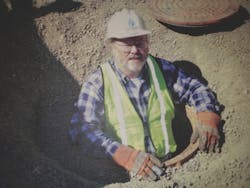About the author:
David Drake is a co-founder and board member of SmartCover Systems, a director of the Rincon del Diablo Water District, and a member of the Executive Committee of the Association of California Water Agencies (ACWA) Joint Powers Insurance Authority (JPIA). He holds a BS in Engineering from Caltech and an MSEE from USC, and is the 2020 WWD Industry Icon. He and his wife, Ginny live in Escondido, California. Drake can be reached at [email protected].
We don’t have to imagine very deeply to gain insight into Imagine a Day Without Water. The city of Cape Town, more than 20 cities in India, and numerous metropolitan areas have faced the threat of a diminished supply of water. There are a variety of root causes for these disasters, including climate change, groundwater overdraft from overpopulation, under-investment in aging infrastructure, poor long-term planning, war and failure of leadership.
Imagine A Day Without Water creates a high bar for each of us—as water professionals—to embrace the responsibility, carry the integrity, and apply the intellectual power to mitigate or avoid these risks altogether. Like most global risks, these things fall on us with subtlety and gradual deterioration, until there is general awareness of the problem.
Can we be better than this? Especially after the coronavirus pandemic, have we not gained enough candor and immediacy to be able to recognize these issues long before they damage our society? Can we be more thoughtful and able to anticipate water supply issues more timely and accurately?
What information do we need? What political will do we need to muster to accomplish this mission? We need to measure supply and demand more carefully and be more incisive in our forecasting. Most critically, we must be candid with ourselves and initiate effective outreach to the public and our fellow leaders. We have to put the pressure on to take the actions necessary to ensure a cohesive solution for our water supply.
Imagine A Day Without Water hits us at every level. At the human level we see the loss of lives, of children, the elderly, everyone. How many people have to carry water for more than an hour each day to provide for their children? How far are those people from a drought disaster? In families, we see the loss of dignity, the ability to protect our loved ones, and fear for our lives. As employers and employees, drought causes a loss of confidence to invest in the future. It also underlines the competitive advantage of having an ample water supply. We have known this for 10,000 years and built our cities accordingly. Unfortunately, things change, yesterday’s river delta is overtaken by rising oceans. Fertile ground becomes arid desert. Within memory, the U.S. Midwest made this transition in the 1930s combined with the falling groundwater table of the Ogallala. The time scale for these issues is moving faster, so there is less time for us to plan, act and manage the results.
One powerful concept is the architecture of Circular Water (or One Water), which is recently gaining a strong voice across the world. This is the move from wastewater to supply water; that all drops are a few steps from being potable. This is especially true when wastewater is not significantly dirtier than local surface water. It also embraces reusing each drop a half dozen times rather than once. In the Western U.S., and similar arid areas, this is fast becoming the default design. It is a travesty to import water and discharge wastewater to the ocean. Wastewater has approximately 5% of the salinity of ocean water with an associated lower demand for electric power. Technology improvements happen every day for filtration and treatment to meet the need for delivered water quality. We can move from “open loop” surface water supply to a “closed loop” engineered water supply.
But what about the cost? In the short term it can be more expensive. In the long term, there is a known future, society can invest safely and citizens can get a reliable and clean water supply. Clearly the long view is the better choice. However, as water and wastewater managers, we have to get better educated, be willing to expand our outreach, and take more calculated risks to succeed. Note that the old “Sloan Management Style” decision making, which calls for maximum return on investment, is really for static conditions. In a world full of unplanned change you must do the whole job, including incisive forecasting.
So, what are our first duties? To inspire, to lead, and to accomplish our mission. The Day Without Water must be fought off with intellect and integrity. We have the charter, resources, able staff and visibility to avoid these disasters. Ask yourself what will you do today to support an ample water supply tomorrow? How will you help others to succeed at this?
